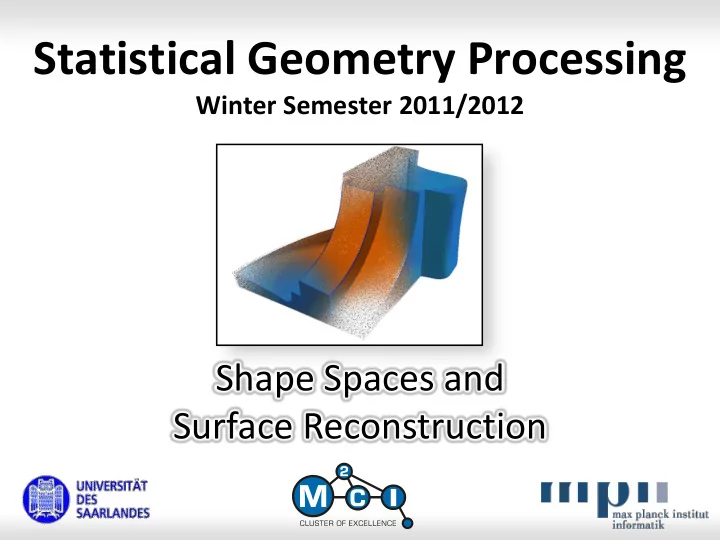

Statistical Geometry Processing Winter Semester 2011/2012 Shape Spaces and Surface Reconstruction
Part I: Mesh Denoising
Surface Reconstruction Goal: Surface reconstruction from noisy point clouds • Input: Noisy raw scanner data • Output: “Nice” surface 3
Statistical Model Bayesian reconstruction • Probability space = S D • S – original model D – measurement data S D • Bayes’ rule: P( D| S ) P( S ) P( S | D ) = P( D ) • Find most likely S 4
Bayesian Approach measurement model prior assumptions (“likelihood”) P( D | S ) P( S ) P( S | D ) = P( D ) optimize (best S) Candidate reconstruction S – Measured data D – 5
Computational Framework Negative log-posterior Compute maximum a posteriori (MAP) solution S D E ( S | D ) ~ E ( D | S ) + E ( S ) measurement prior potential potential reasonable data fitting reconstruction? 6
Statistical Model Generative Model: original curve / surface noisy sample points 7
Statistical Model Generative Model: 1. Determine sample point (uniform) 2. Add noise (Gaussian) sampling Gaussian noise many samples distribution (in space) 8
Denoising: Vertex Displacement original scene S sample noise measurement D Measurement Model (Assignment #4): 1. Sampling: choose subset of measured points (known) 2. Noise: shift measured points randomly according to (known) p noise ( x 1 ,..., x m ) 9
Measurement Model Noise Model • Most simple: Independent, Gaussian noise • Negative log-likelihood: 1 m 1 T log p ( D | S ) ( s d ) ( s d ) c i i i i i 2 i 1 10
Why do We Need Priors? No Reconstruction without Priors • Measurement itself has highest probability measurement D 11
Priors N( i ) Shape Prior • Generic Prior 𝐲 Smooth surfaces x i • Example (assignment sheet): Points are expected to lie at the mean of their neighbors “ Laplacian ” prior: 2 1 𝑜 𝐹 𝑇 = 𝐹(𝐲 1 , … , 𝐲 𝑜 )~ 𝑂 𝑗 𝐲 𝑗 − 𝐲 𝑘 i=1 j∈N i • Formal integrability of P(S) Limit to bounding box, large Gaussian window Omit in practice 12
Denoising Model Data fitting D E ( D | S ) ~ i dist( S , d i ) 2 S Prior: Smoothness E s ( S ) ~ S curv( S ) 2 S 13
Parametrization Parametrization • Need to know neighborhood • Here, we assume this is known (denoising vs. full reconstruction Optimization • Minimize E ( S | D ) • Here: Solve linear system 14
Example data optimized mesh 15
Extensions Piecewise smooth objects • Additional (heuristic) segmentation step • Modify priors at edges • Man-made objects 16
MRF Structure Markov Random Field (MRF) data D reconstruction S data fitting (per node) smoothness (local neighborhoods) 17
Shape Spaces
Shape Spaces Mesh Denoising • Fixed topology (fixed mesh) • n v ertices can move around • Space: ℝ 3𝑜 • On this space: Probability density 𝑞 𝐲 , 𝑞: ℝ 3𝑜 → ℝ + Alternatively: energy 𝐹 𝐲 = −log 𝑞 𝐲 , 𝐹(𝐲): ℝ 3𝑜 → ℝ + Minimize E, maximize p E does not need to integrate to one (more general) 19
General Concept General shape spaces: • Mapping from sphere to ℝ 3 (fixed topology) • Implicit functions in ℝ 3 General topology But redundancy for off-surface points • Point-based models Topology implicit Hard to capture • How to describe more specific priors? Our model is a stationary MRF (typical choice) “Space of all people”, “Space of all houses”? 20
Recommend
More recommend